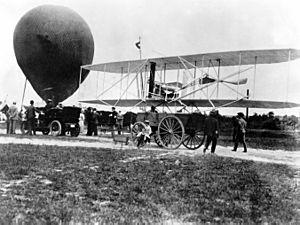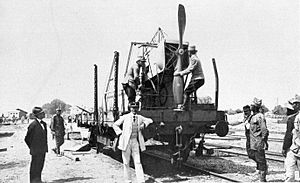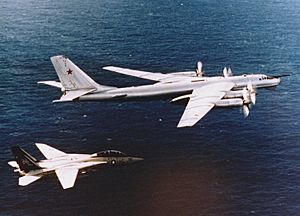Military aviation facts for kids
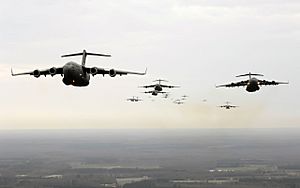
Military aviation is all about using aircraft and other flying machines for war. This includes planes that fight battles and planes that carry supplies to soldiers. It's a big part of a country's airpower, which means how strong its air forces are. Military aircraft come in many types, like bombers, fighters, transport planes, trainer aircraft, and reconnaissance aircraft (for spying).
Contents
History of Military Aviation
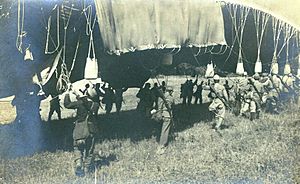
The very first time flying machines were used in war was with lighter-than-air balloons. In 1794, during the Battle of Fleurus, the French used an observation balloon to watch Austrian troops. Balloons were often used in the 1800s, including during the American Civil War. They were used in wars until shortly after World War II, when planes became much better.
Planes were quickly seen as useful for the military, even though early models were very basic. The U.S. Army Signal Corps bought the first military airplane, a Wright Model A, on August 2, 1909. In 1911, Italy used various planes for spying and bombing during the Italo-Turkish War. On October 23, 1911, an Italian pilot, Captain Carlo Piazza, flew the world's first air spying mission. On November 1, the first ever aerial bomb was dropped by Giulio Gavotti from an Etrich Taube plane. The Turkish soldiers, who didn't have anti-aircraft weapons, were the first to shoot down a plane using rifles.
At first, planes were mostly used for reconnaissance (spying). But by the end of World War I, military aviation had many special jobs. These included spotting artillery, fighting other planes, bombing, attacking ground targets, and looking for submarines. Plane technology improved incredibly fast during this time.
Between the two big world wars, planes kept getting better. Engines, designs, and weapons all improved. This led to even faster progress during World War II. Planes could fly faster and higher, and new roles appeared. These included Airborne Early Warning (giving early warnings of enemy planes), electronic warfare, and even flying lifeboats. Great Britain used planes to stop rebellions and introduced the first military transport planes. These planes changed how supplies and troops were moved, making it much faster to deliver them over long distances.
During World War II, U-boats (German submarines) made it hard for the Allies to move troops and supplies to Europe. This led to the creation of very long-range Maritime patrol aircraft. These planes could find and destroy submarines using new systems like sonobuoys (underwater listening devices), Leigh Lights (powerful searchlights), and radar. They also had better weapons like homing torpedoes and improved depth charges. This helped the Allies win the Battle of the Atlantic. Planes also played a huge role in many battles, like the Battle of Britain and the attack on Pearl Harbor. The war against Japan ended when two planes dropped atomic bombs on Hiroshima and Nagasaki. Many important inventions from World War II, like the jet engine, radar, early missiles, helicopters, and computers, are still used today.
After World War II, the Cold War between the superpowers pushed military aviation to develop even more. The helicopter became a vital part of military forces, carrying troops and helping smaller warships find submarines. The U.S.S.R. and the United States competed to build better planes and technology. The Korean War and the Vietnam War tested these new designs. Electronics made huge leaps, starting with early computers in World War II. Computers now help with communications, spying, and controlling remotely piloted aircraft (drones).
In the early 1960s, many thought missiles would replace planes with pilots and their guns. But missiles weren't as flexible or effective as manned planes. They were also expensive for attacking ground targets. So, in the 1970s, planes with guns became important again, and designers focused more on how well planes could move. From the 1980s until now, stealth technology (making planes hard to detect) and other ways to hide from enemies have been very important.
Today, a country's military aircraft are often the first to defend against an attack or to strike the enemy. Strong military aviation has been key in many recent conflicts, like the Gulf War.
Types of Military Aircraft
There are many different kinds of military aircraft, each with a special job:
Airborne Early Warning Aircraft
These planes give early warnings about enemy activities. They help prevent surprises. Many can also direct friendly fighter planes to intercept incoming enemy aircraft.
Bombers
Bombers carry large amounts of bombs. They might be slower or less agile to carry more weapons.
Experimental Aircraft
These planes are built to test new ideas for how planes fly, their structure, electronics, or engines. They are usually full of sensors that send data to ground stations during test flights.
Fighter Aircraft
Fighters are designed to control the sky. They need to be fast and agile. They carry different weapons, like machine guns and guided missiles, to fight other planes.
Forward Air Control Aircraft
These planes help direct other aircraft that are supporting ground troops. They make sure bombs or missiles hit the right targets and don't harm friendly soldiers.
Ground-Attack Aircraft
These planes help ground troops by attacking enemy defenses. Helicopter gunships and special ground-attack planes target enemy tanks or soldiers and provide close support for troops on the ground.
Liaison Aircraft
These are usually small, unarmed planes used to deliver messages or important people.
Maritime Patrol Aircraft
These planes are used to patrol the seas. They often have special electronic gear to find and sink submarines, like sonar. They are also used for search and rescue missions and to watch over fishing areas.
Multirole Combat Aircraft
These planes can do many jobs, like being a fighter or a bomber, depending on what the mission needs.
Reconnaissance Aircraft
Reconnaissance aircraft and scout helicopters are mainly used to gather information. They have cameras, infrared sensors, radar, and television sensors. Today, spy satellites and unmanned aerial vehicles (drones) are often used for this job too.
Refueling Aircraft
These planes refuel fighters and reconnaissance aircraft in the air. This helps other planes fly longer and reach farther. Examples include the KC-135 and KC-46. Many countries use these planes as part of their military.
Training Aircraft
Training aircraft are used to teach new pilots how to fly. They also provide extra training for special jobs, like air combat.
Transport Aircraft
Transport aircraft carry troops and supplies. Cargo can be loaded onto special pallets for quick unloading. Both cargo and people can also be dropped from flying planes using parachutes. This group also includes aerial tankers, which can refuel other aircraft while flying. Helicopters and gliders can carry troops and supplies to places where other planes can't land.
Air Forces
An air force is a part of a country's military that focuses on fighting in the air. It's separate from the army or navy. Most countries have an air force, or at least an air wing if they are smaller. Air forces usually protect a country from air attacks, carry out strategic bombing, gather intelligence, manage battles, and transport goods. They might also handle space operations, like using satellites for spying.
Other Military Aviation
Besides a dedicated air force, other parts of a country's military might also use aircraft. This includes naval aviation (aircraft used by the navy) and army aviation (aircraft used by the army). Sometimes, coast guard services or police-like forces (like gendarmeries) also use aircraft.
See also
 In Spanish: Aviación militar para niños
In Spanish: Aviación militar para niños
- Civil aviation
- Military aviation occupations
- Military aircraft insignia


